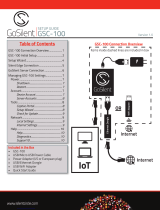
3
CONTENTS
Page
1. Symbols used in this document 4
2. Scope of these instructions 4
3. Product description 4
4. Applications 4
4.1 Pumps 4
4.2 Control variant 4
5. Nameplate 5
6. Software label 5
7. Type key 6
8. Overview of control variants, examples 7
9. Installation 9
9.1 Mechanical installation 9
9.2 Electrical installation 9
9.3 Start-up 9
10. Control panel 9
10.1 Display (pos. 1) 10
10.1.1 Menu line 10
10.1.2 Top line 10
10.1.3 Graphical illustration 10
10.1.4 Scroll bar 10
10.1.5 Bottom line 10
10.2 Buttons and indicator lights 10
10.2.1 Arrow to the right (pos. 2) 10
10.2.2 Help (pos. 3) 10
10.2.3 Up and down (pos. 4 and 5) 10
10.2.4 Plus and minus (pos. 6 and 7) 10
10.2.5 Esc (pos. 8) 10
10.2.6 Home (pos. 9) 10
10.2.7 Ok (pos. 10) 10
10.2.8 Indicator lights (pos. 11 and 12) 10
10.2.9 Contrast (pos. 13) 10
10.2.10 Back light 10
11. Functions 11
11.1 Tree of functions 11
11.2 Overview 13
11.3 Description of functions 15
11.4 Status (1) 15
11.4.1 Current alarms (3.1) 15
11.4.2 System (1.2) 15
11.4.3 Operating mode (1.2.1) 16
11.4.4 Setpoint (1.2.2) 16
11.4.5 Setpoint influence (1.2.3) 16
11.4.6 Measured values (1.2.4) 17
11.4.7 Analog inputs (1.2.5) 17
11.4.8 Pump 1...6 (1.3 to 1.8) 17
11.5 Operation (2) 18
11.5.1 Operation (2) 18
11.5.2 System operating mode (2.1.1) 18
11.5.3 Control mode (2.1.2) 19
11.5.4 Setpoints (2.1.3) 21
11.5.5 Individual pump control (2.1.4) 21
11.5.6 Setting of individual operating mode
(2.1.4.1 to 2.1.4.6) 22
11.6 Alarm (3) 23
11.6.1 Alarm status (3) 23
11.6.2 Current alarms (3.1) 24
11.6.3 Alarm log (3.2) 24
11.7 Settings (4) 25
11.7.1 Primary controller (4.1) 25
11.7.2 PI controller (4.1.1) 26
11.7.3 Alternative setpoints (4.1.2) 27
11.7.4 Alternative setpoints 2 to 7 (4.1.2.1 to 4.1.2.7) 27
11.7.5 External setpoint influence (4.1.3) 28
11.7.6 Setting of influence function (4.1.3.2) 29
11.7.7 Primary sensor (4.1.4) 29
11.7.8 Clock program (4.1.6) 30
11.7.9 Proportional pressure (4.1.7) 31
11.7.10 S-system configuration (4.1.8) 31
11.7.11 Pump cascade control (4.2) 32
11.7.12 Min. time between start/stop (4.2.1) 32
11.7.13 Max. number of starts/hour (4.2.1) 32
11.7.14 Standby pumps (4.2.3) 33
11.7.15 Forced pump changeover (4.2.4) 33
11.7.16 Pump test run (4.2.5) 34
11.7.17 Pilot pump (4.2.6) 34
11.7.18 Pump stop attempt (4.2.7) 35
11.7.19 Pump start and stop speed (4.2.8) 35
11.7.20 Min. performance (4.2.9) 36
11.7.21 Compensation for pump start-up time (4.2.10) 36
11.7.22 Secondary functions (4.3) 37
11.7.23 Stop function (4.3.1) 37
11.7.24 Soft pressure build-up (4.3.3) 39
11.7.25 Emergency run (4.3.5) 40
11.7.26 Digital inputs (4.3.7) 40
11.7.27 Functions of digital inputs (4.3.7.1) 41
11.7.28 Analog inputs (4.3.8) 41
11.7.29 Analog inputs (4.3.8.1 to 4.3.8.7) 42
11.7.30 Analog inputs and measured value
(4.3.8.1.1 to 4.3.8.7.1) 42
11.7.31 Digital outputs (4.3.9) 43
11.7.32 Functions of digital outputs (4.3.9.1 to 4.3.9.16) 43
11.7.33 Min., max. and user-defined duty (4.3.14) 44
11.7.34 Min. duty (4.3.14.1) 44
11.7.35 Max. duty (4.3.14.2) 45
11.7.36 User-defined duty (4.3.14.3) 45
11.7.37 Pump curve data (4.3.19) 46
11.7.38 Control source (4.3.20) 47
11.7.39 Fixed inlet pressure (4.3.22) 47
11.7.40 Flow estimation (4.3.23) 48
11.7.41 Monitoring functions (4.4) 48
11.7.42 Dry-running protection (4.4.1) 49
11.7.43 Dry-running protection with pressure/level switch
(4.4.1.1) 49
11.7.44 Dry-running protection with pressure transmitter
(4.4.1.2) 50
11.7.45 Dry-running protection with level transmitter
(4.4.1.3) 50
11.7.46 Min. pressure (4.4.2) 51
11.7.47 Max. pressure (4.4.3) 51
11.7.48 External fault (4.4.4) 52
11.7.49 Limit 1 and 2 exceeded (4.4.5 and 4.4.6) 52
11.7.50 Pumps outside duty range (4.4.7) 53
11.7.51 Pressure relief (4.4.8) 54
11.7.52 Functions, CU 351 (4.5) 55
11.7.53 Display language (4.5.1) 55
11.7.54 Display units (4.5.2) 56
11.7.55 Date and time (4.5.3) 57
11.7.56 Passwords (4.5.4) 57
11.7.57 Ethernet (4.5.5) 58
11.7.58 GENIbus number (4.5.6) 58
11.7.59 Software status (4.5.9) 58
11.8 Data communication 59
11.8.1 Ethernet 59
11.8.2 GENIbus 60
12. Measuring parameters 61
12.1 Transmitter types 61
12.2 Parameter list 61
13. Fault finding chart 62
14. Maintenance 63
14.1 CU 351 63
15. Taking out of operation 63
16. Technical data 63
16.1 Temperature 63
16.2 Relative humidity 63
17. Electrical data 63
18. Related documents 63
19. Disposal 63





















